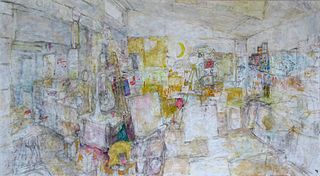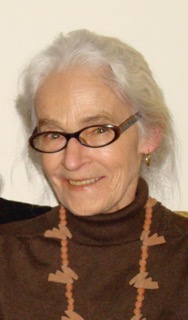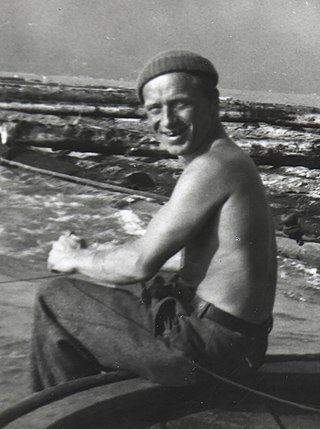
Emily Carr was a Canadian artist who was inspired by the monumental art and villages of the First Nations and the landscapes of British Columbia. She also was a vivid writer and chronicler of life in her surroundings, praised for her "complete candour" and "strong prose". Klee Wyck, her first book, published in 1941, won the Governor General's Literary Award for non-fiction and this book and others written by her or compiled from her writings later are still much in demand today.

Sophia Theresa "Sophie" Pemberton was a Canadian painter who was British Columbia's first professional woman artist. Despite the social limitations placed on female artists at the time, she made a noteworthy contribution to Canadian art and, in 1899, was the first woman to win the Prix Julian from the Académie Julian for portraiture. Pemberton also was the first artist from British Columbia to receive international acclaim when her work was exhibited at the Royal Academy in London (1897).
Susanna Blunt is a Canadian portrait artist who designed the most former portrait of Queen Elizabeth II on the former Canadian coinage, first issued in 2003. She was the second Canadian woman to design a portrait of a monarch the first being Dora de Pedery-Hunt.
James Williamson Galloway Macdonald, commonly known in his professional life as Jock Macdonald, was a member of Painters Eleven, whose goal was to promote abstract art in Canada. Macdonald was a trailblazer in Canadian art from the 1930s to 1960. He was the first painter to exhibit abstract art in Vancouver, and throughout his life he championed Canadian avant-garde artists at home and abroad. His career path reflected the times: despite his commitment to his artistic practice, he earned his living as a teacher, becoming a mentor to several generations of artists.
Sylvia Tait is a Canadian abstract painter and printmaker.

Gordon Allen Rice is a Canadian artist.
Maria W. Tippett L.L. D., D.Litt ( ) was a Canadian historian specialising in Canadian art history. Her 1979 biography of Emily Carr won the Governor General's Award for English-language non-fiction.

Audrey Capel Doray is a Canadian artist working in a variety of mediums—painting, printmaking, electronic art, murals, and films. In addition to her solo and group exhibitions, her work was exhibited at the 6th Biennial Exhibition of Canadian Painting at the National Gallery of Canada in 1965. A serigraph Diamond is held in the Tate Gallery London and the National Gallery of Canada. Her work is described in North American Women Artists of the Twentieth Century as combining "robust social criticism with her own interpretation of humanist theory" and dealing with pop art and the feminist archetype, themes of "perpetual motion and endless transition," and the interplay of sound and light.
Marianna Schmidt was a Hungarian-Canadian artist who worked primarily as a printmaker and painter.
Ellen Vaughan Kirk Grayson was a Canadian artist and educator. She was born in Moose Jaw, Saskatchewan but her time spent hiking in the Canadian Rockies and the Okanagan Valley has shaped her artistic style.

Allyson Clay is a Canadian visual artist, curator, and educator based in Vancouver, B.C.
Sherry (Sherrard) Grauer is a mixed-media painter, sculptor, and relief artist. Her work "is noted for negotiating the boundary between painting and sculpture, in regards to her experiments with relief and surface volume."

Hans Karl Hesse, known in later life as Carle Hessay, was a German-born Canadian painter. Although much remains uncertain of his early years, he immigrated to Canada in 1927, and later studied at art academies in Dresden and Paris. Hessay served as a Canadian soldier in World War II. After the establishment of peace, he moved to British Columbia, eventually settling in the town of Langley, where he took up art again in the 1950s. Some of his early paintings were done in the manner of Romantic realism. The influence of Expressionism soon became significant, with Hessay drawing on both the European and American movements, together with aspects of Emily Carr and the Group of Seven. He painted landscapes throughout his artistic life, as well as cityscapes, the Spanish Civil War, Biblical prophecy, and conceptions of the far future. A sizable fraction of his output consisted of abstract pieces. Over time, Hessay's depictions grew more symbolic, one commentator describing his late work as "brazenly metaphysical and apocalyptic". He often made his own pigments, and his style is distinguished by his use of colour, especially black. In 2014, a group of Canadian writers published poems based on his small abstracts. Hessay was the subject of a 2017 documentary film and art exhibition at the University of Victoria.
Charmian Johnson was a Canadian artist and potter based in Vancouver, British Columbia.
Torrie Groening, born in 1961 in Port Alberni, British Columbia, is a photographer and artist based out of Vancouver, British Columbia, Canada. Her art practices include drawing, painting, printmaking, and installation art. Groening is an alumna of the Visual Arts department of The Banff Centre and attended Emily Carr College of Art & Design where she studied printmaking.
Judith Schwarz is a Canadian visual artist. Her work has been featured in exhibitions since 1979.
Barbara Spohr (1955–1987) was a Canadian photographer.
Nan Lawson Cheney (1897–1985) was a Canadian painter and medical artist.
Elisabeth Margaret Hopkins, born in Fort Gilkicker, Hampshire, England, was a painter and writer in British Columbia.
Joan Willsher-Martel was a painter of abstract and pointillist landscapes, in watercolour, drawings and oils.





